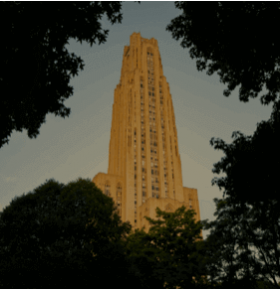
Subscribe to Pittwire Today
Get the most interesting and important stories from the University of Pittsburgh.For Lola Dardzinski of New Hope, Pennsylvania, learning she could get a Pitt Success Pell Match put the University of Pittsburgh above all her other college options. She’s graduating this spring with a degree in applied developmental psychology from the School of Education — and in better financial standing than if she attended another college.
“I very badly wanted to attend a university in a city, but city schools didn’t offer me the type of financial aid that the rural schools in my area were — that is, until I heard back from Pitt about a Pell match,” said Dardzinski (pictured above, left).
When Pitt launched the Pitt Success Pell Match Grant Program in 2019, it was the first initiative of its kind among public universities to provide a dollar-for-dollar match to students’ Federal Pell Grants. To date, Pitt has invested $139 million in supporting Pell Grant recipients to obtain college degrees.
“Implementing the vision of the provost, we created the Pitt Success program with the goals of reducing students' unmet financial needs and increasing the retention rate of Pell-eligible students,” said Kellie Kane, associate vice provost for enrollment.
Since the program's inception, Pell-eligible graduates have graduated with less debt than their counterparts each year. 12,613 students have benefited from the program, including 1,092 students in the Class of 2023, the first cohort who were eligible to receive a Pitt Success Pell Match in their first year of enrollment.
“Pell-eligible students traditionally run a greater risk of quitting college, either during or directly after their first year, but since we started Pitt Success, we’ve increased the number of first-year Pell Grant recipients returning to Pitt for a second year,” said Joe McCarthy, vice provost for undergraduate studies.
In the three years before the launch of the Pitt Success Pell Match program, first-year Pell-eligible students continued to their sophomore year 88% of the time, but in the three years since the beginning of Pitt Success, those students remained enrolled 91% of the time.
“While the program has not been in place long enough to gauge a four-year graduation rate, the four-year retention rate has increased by 4 percentage points. So, we expect the graduation rate to increase, perhaps substantially,” McCarthy said.
“The financial resources I received from Pitt helped alleviate the stress of paying for college. I can participate in internships, research opportunities and networking events, in addition to academics,” said Kyrian Elekwachi of Baltimore, a graduating senior in the Kenneth P. Dietrich School of Arts and Sciences (pictured above, right). “Education may start in the classroom, but it doesn't have to end there as well,” he added.
“Without a Pitt Success grant, I wouldn't have had the opportunity to receive an education at this level,” said Elekwachi, who’s majoring in neuroscience and minoring in Africana studies and chemistry.
“The financial resources I received helped alleviate the stress of paying for college. I could participate in extracurricular activities, research opportunities and networking events, in addition to academics.”
Pitt Success by the numbers
- $139 million invested by Pitt in supporting Pell Grant recipients
- 12,000+ students have received a boost from the program
- $11,716 yearly average grant size for all campuses, including both the match and the Federal Pell Grant
— Nichole Faina, photography by Aimee Obidzinski


